Exploring New York’s Industrial Past in "Cathedrals of Industry"
Join photographer Michael L. Horowitz for a journey through 50 years of photographs!


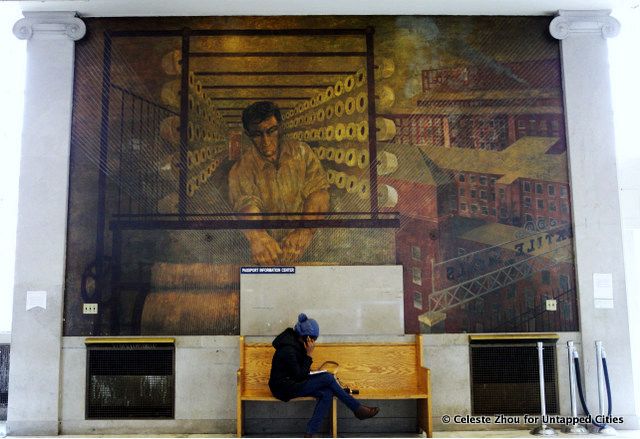
New York City has more than its share of art. Works of art can be found throughout the city, in museums, galleries, and even scattered across its parks. However, an often overlooked venue for art in New York City are post offices. During the Great Depression, federal agencies including the
Treasury Department’s Section of Painting and Sculpture, often confused and conflated with the WPA, hired painters and sculptors to“secure suitable art of the best quality available for the embellishment of public buildings.”
Between 1934 and 1943, the Section, as it was known, commissioned works of art for more than 1,100 post offices across the United States. While some of the murals and sculptures have been lost or destroyed, most of the ones created for New York City post offices can still be viewed in situ. With the USPS closing and selling off a large percentage of its post offices, highlighting these works of art commissioned for the public is more important than ever.

In 1912, the James A. Farley Post Office Building opened. The building, originally referred to as the General Post Office, was designed by McKim, Mead, and White to complement their nascent Pennsylvania Station. The 8th Avenue facade possesses an extended staircase rising to fifty-three corinthian columns topped by a frieze with a quote, often mistaken for the post office’s official motto. The quote, “Neither snow nor rain nor heat nor gloom…,” was adopted, and amended, from Herodotus describing the couriers of King Xerxes, along with inscriptions of names related to postal history, like Cardinal Richelieu and King Louis XVI.
In the 1930s, Louis Lozowick, a Russian painter and art critic, painted two large oil painting in the lobby of the post office. Triborough Bridge and Lower Manhattan can still be viewed today, although the lower portion of Lower Manhattan has been covered by a memorial plaque (the lower portion can be seen on the original drawing). There are also remnants of a mural at the Annex to the Farley Post Office Building, which is unfortunately inaccessible to the public. This may change however, as the plans to convert the Farley Post Office into a train station and Amtrak waiting room got another jump start from Governor Cuomo yesterday.
Next, check out some of the James A. Farley Post Office’s off-limits places.

The Bronx General Post Office, located on the Grand Concourse, was constructed between 1934 and 1937 and designed by Thomas Harlan Ellett and Louis A. Simon. The gray brick building almost camouflages into the streetscape but its real treasure lies inside, where there are thirteen murals by Ben Shahn and Bernarda Bryson Shahn entitled “Resources of America.” The paintings were inspired by Walt Whitman’s poem I Hear America Singing.
In one of the panes, Whitman points to a blackboard with a verse from his poem. Originally it was supposed to read – “to recast poems, churches, art; (Recast, maybe discard them, end them – Maybe their work is done, who knows).” However, a Fordham University ethics professor argued that the passage was an “insult to all religiously minded men and to Christianity.” As a result, Shahn took a different quote from Whitman’s poem, likely afraid his work might meet the same fate of an earlier mural he worked on – Diego Rivera’s Rockefeller Center mural “Man at Crossroads.” On your way out make sure to stop by and admire the two pieces of artwork on the buildings facade, “The Letter,” by Henry Kreis, and “Noah,” by Charles Rudy.
Check out 7 other architectural sites along the Grand Concourse
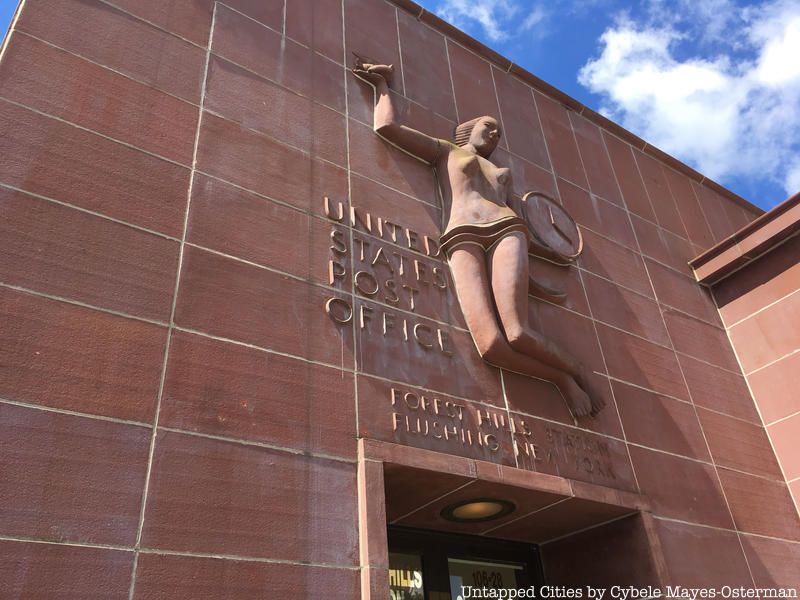
The Forest Hills Post Office is located on Queens Boulevard, near the 71st (Continental) Avenue stop on the E/F. The building was constructed pursuant to the Emergency Construction Program Act in the Art Deco style. It is adorned with a 1938 sculpture by Sten Jacobson entitled “The Spirit of Communication.” Interestingly, the building has not been designated a landmark by the City’s Landmarks Preservation Commission.
Next: Read about the Rebirth of the Forest Hills Stadium

The Jackson Heights States Post Office is located in a Colonial Revival style building on south side of 37th Avenue in Queens. In 1940, a mural, by Peppino Mangravite entitled “Development of Jackson Heights,” was installed in the post office. Mangravite was paid $1,500 his work. He also painted murals for the Atlantic City and Hempstead post offices. Mangravite’s paintings can be found at a number of museums including the Metropolitan Museum of Art and the Whitney Museum.

The Woodhaven Post Office is located on Forrest Park Avenue. It is located in a 1930s Art Deco style building. It is fronted by two pedestals topped with flowerpots that are reminiscent of similar decorative features installed in front of some City parks. The Post Office is located near the house in which Betty Smith wrote A Tree Grows in Brooklyn, both structures are demarcated with historical posts. The post office is decorated with Ben Shan’s mural entitled First Amendment. The mural was designed in response to Roosevelt’s commitment to the Four Freedoms (press, speech, religion, and assembly), of which the Roosevelt Island Four Freedoms Park commemorates. The mural depicts the Statue of Liberty, a New York State voters’ ballot, workers marching in protest, and the Supreme Court building.

The Wakefield branch of the Post Office is located under the elevated IRT (2/5) subway tracks on White Plains Road in the northeastern Bronx. From the outside, the building appears to be fairly reserved, with a relatively plain white brick exterior. Inside, it is one of two Bronx Post Offices to possess WPA era murals. The mural was designed by Abraham Lishinsky and Irving A. Block and installed in 1942. Entitled, Washington and the Battle of the Bronx, the mural depicts a winter scene centered around Washington on horseback surrounded by soldiers, a cannon, a Native American, and a house that looks eerily like Poe’s Cottage.
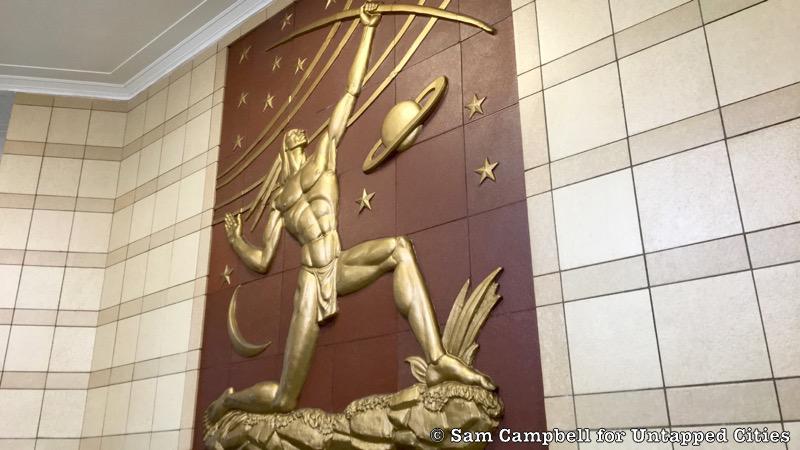
The Canal Street Post Office is located on the southeast corner of Canal Street and Church Street. The building was constructed in 1937 in the Art Moderne style, in the same vein as the main branch of the Brooklyn Public Library. The building contains an outstanding Art Deco bas relief designed by Wheeler Williams and installed in 1938.
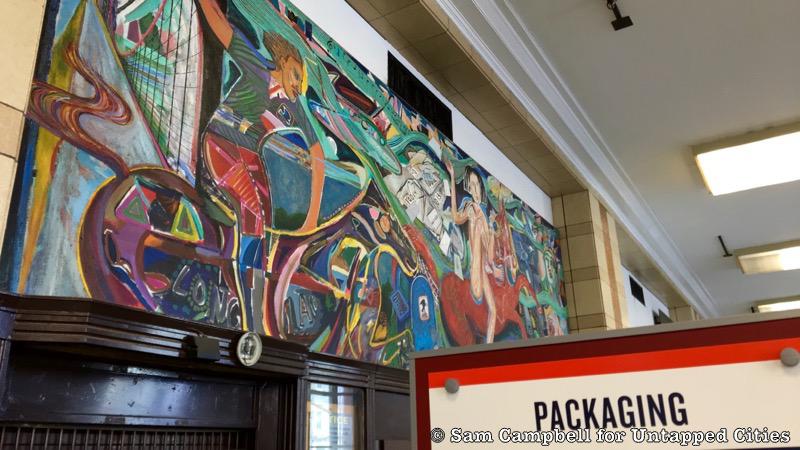
Williams’ art can be seen across the country, though most New Yorkers will be familiar with his bas relief of Venus on the facade of the Parke-Bernet Galleries building on Madison Avenue. The image, which is reminiscent of Rockefeller Center‘s artwork, depicts a Native American pictured in a majestic pose with his bow aimed towards the heavens surrounded by the stars, the Moon, and Saturn.

The Madison Square Post Office is located on the north side of 23rd Street between Lexington Avenue and 3rd Avenue. The building was constructed in 1937 in the Classical Revival, or arguably Art Deco, style and is similar to a truncated version of the Bronx Borough Hall. The post office contains eight panels (spread across three walls) by Kindred McLearly. The paintings depict the quotidien lives of New Yorkers and are similar to Reginald Marsh’s city scenes. The exterior of the post office is home to Edmond R. Amateis’ and Louis Slobodkin’s “Communication” series of bas reliefs.
If you stop by the Madison Square Post Office, check out some of the City’s overlooked Skybridges.
 217 W. 18th Street
217 W. 18th Street
The Old Chelsea Post Office is located on the north side of 18th Street between 7th and 8th Avenues. The building was constructed in 1937 and possesses a simple brick facade. The interior contains two bas-reliefs by Paul Fiene, “Deer” and “Bears.” The pastoral bas reliefs complement the simplicity of the building. The Old Chelsea Post Office, with its remnants of the pneumatic tube mail network, is one of the many properties that the USPS has considered putting up for sale.
While in Chelsea check out Pier 54, a pier with a tragic history.
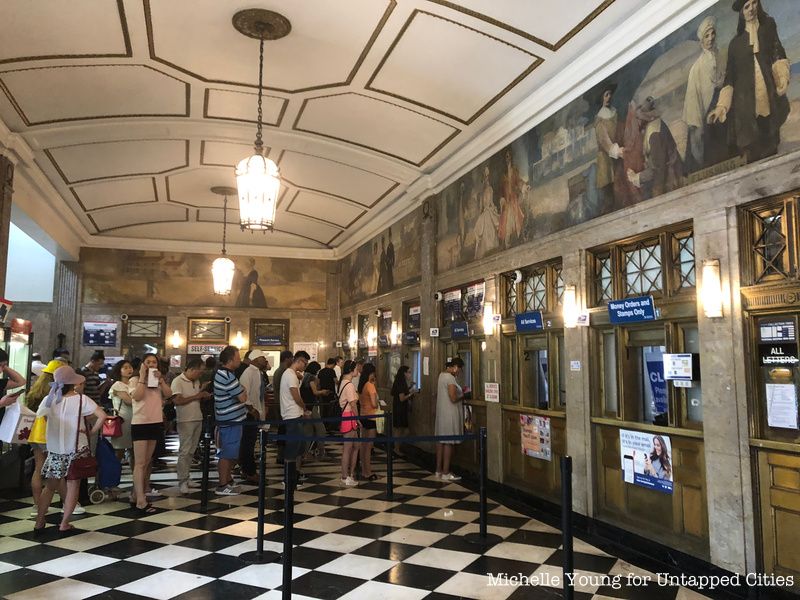
The Flushing Post Office was completed in 1934 and was designed in the Neo-Georgian or Colonial Revival style. The Main Street building was designed by Dwight James Baum and William W. Knowles. The interior of the building is graced by a series of murals depicting the twelve communities served by the post office. The murals were painted by Vincent Aderente, whose work can also be seen at the Waldorf Astoria, Queens County Court House, Kings County Hospital, and the Long Island Savings Bank.
Next, check out 5 remnants of pneumatic tubes networks in New York City and the Top 10 Secrets of Grand Central Terminal.
Subscribe to our newsletter